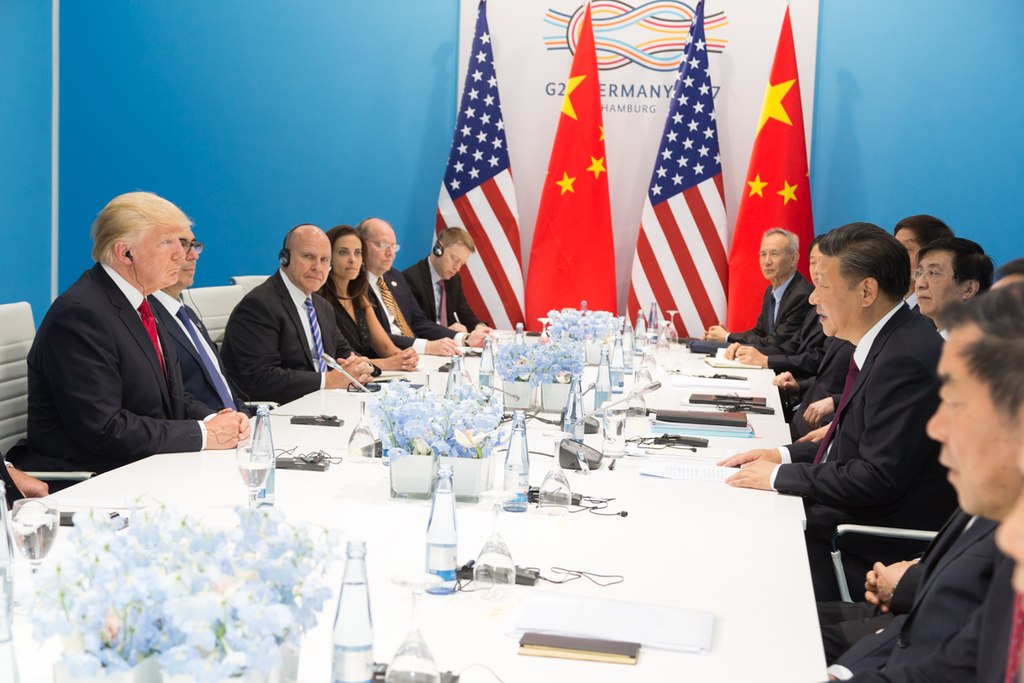SinoTech: Trump Administration Escalates Tech Trade Conflict
President Trump threatened to impose tariffs against all Chinese imports to the United States in an interview with CNBC last Friday, stoking fears of an all out trade war between the two countries.

Published by The Lawfare Institute
in Cooperation With

President Trump threatened to impose tariffs against all Chinese imports to the United States in an interview with CNBC last Friday, stoking fears of an all out trade war between the two countries. The president’s threatened tariffs would affect more than $500 billion in goods and mark the apotheosis of a rapid escalation in rhetoric. It all began when the Trump administration imposed 25 percent tariffs against $50 billion in Chinese tech imports in early July and accelerated when the administration identified an additional $200 billion in Chinese imports the next week that will be considered for 10 percent tariffs. The Chinese government promised to “take necessary counter-measures” against the $200 billion tariff cycle, although it will no longer be able to retaliate in-kind, as U.S.exports of goods to China totaled less than $130 billion last year. Instead, the Chinese government will likely turn to currency devaluation, investment restrictions, and diplomatic action.
As the trade conflict has escalated, the Trump administration’s objectives have become blurred; concerns about the overall trade deficit appear to have bled into a struggle that was initially focused on China’s tech l development policies. The conflict began in August of last year, when the Trump administration instructed the United States Trade Representative (USTR) to open an investigation into China’s technology transfer policies under Section 301 of the Trade Act of 1974. The USTR completed its investigation in March, concluding that the Chinese government’s policies, most notably its “Made in China 2025” plan for technological development, “involve[d] the acquisition of foreign technologies through acts, policies, and practices of the Chinese government that are unreasonable or discriminatory and burden or restrict U.S. commerce.” Later that day, the Trump administration instructed USTR to consider implementing tariffs, investment restrictions, and WTO complaints to counteract the Chinese government’s technology policies. The USTR then released a list of $50 billion in targeted products that “benefit from Chinese industrial policies” in April and, after notice and comment, published a final list of “products containing industrially significant technology” on June 20.
Those tariffs went into partial effect against an initial $34 billion in goods on July 6, while hearings on the final $16 billion of that tariff cycle will be held on Wednesday and Thursday. China immediately responded to the July 6 tariffs by imposing in-kind tariffs against $34 billion-worth of U.S. imports, with an additional $16 billion in waiting. The USTR, at President Trump’s urging, retaliated on July 17 by proposing tariffs against an additional $200 billion in Chinese goods, which will now undergo notice and comment procedures, and come into effect. But those supplemental tariffs do not target Chinese technological products; instead, the USTR acknowledges that they include “products from across all sectors of the Chinese economy.” And, while ostensibly directed toward “obtaining the elimination of the acts, policies, and practices covered in the [USTR’s original] investigation,” those tariffs threaten to escalate the tech trade conflict into a retaliatory war completely unmoored from its original objectives. The president’s threat to impose tariffs against all Chinese imports could complete that process. While the obfuscation of this trade conflict may have been inevitable, tying U.S. concerns about China’s technology transfer and intellectual property regimes to the president’s ambition to lower the trade deficit is unlikely to make either task easier.
China Considers New Retaliatory Measures
The U.S government’s proposed tariffs may force the Chinese government to adopt new, more creative countermeasures, as the U.S.-China trade deficit will prevent them from retaliating fully through in-kind tariffs. Instead, Beijing is likely to make life more difficult for U.S. firms operating in Chinese markets by withholding approval for mergers and acquisitions and by deferring necessary licenses. The flexibility of the Chinese retaliation, however, will be limited by the government’s desire to portray itself as a defender of the international economic order, as well as by concerns about how an all-out war would impact China’s economic development.
The Chinese government has also challenged the Trump administration’s proposed billion tariffs at the WTO, filing an addendum to the complaint it launched in April against the Trump Administration’s initial tech tariffs. U.S. officials quickly struck back with a response, accepting China’s request for consultations but suggesting that China could not condemn U.S. retaliatory tariffs when Beijing was itself imposing retaliatory tariffs against U.S. goods. Washington also initiated a new WTO dispute against China’s $34 billion retaliatory tariffs on July 16, one of five disputes opened by the U.S. on that day. The other four disputes concern retaliatory tariffs imposed by American allies Mexico, Canada, Turkey, and the European Union in response to U.S. steel and aluminum tariffs.
Attention has also turned to the Yuan, which has declined 7% against the dollar since April, leading some to suspect that Chinese officials are allowing the value to drop to counteract U.S. tariffs. Chinese officials have denied any desire to devalue the currency, but U.S. treasury officials are reportedly keeping a close eye for signs of currency manipulation.
U.S. Lifts ZTE Ban
Three months after the U.S. Department of Commerce imposed a denial order banning Chinese telecommunication giant ZTE from purchasing U.S.-made components, and two months after President Trump and President Xi struck a deal to grant ZTE reprieve, the department has officially lifted the ban after determining that ZTE had complied with the terms of its settlement. Commerce Secretary Wilbur Ross promised that his department would “remain vigilant” in monitoring ZTE’s compliance through “three-interlocking elements”--a suspended denial order, $400 million deposited by ZTE in escrow, and a compliance team chosen by, and reporting to, the U.S. Government. ZTE’s new management also promised to keep compliance as its top priority. Newly appointed CEO Xu ZiYang demanded stringent cost-cutting measures, but it will still take weeks for ZTE to get plants up to full speed because of worker shortage.
Congress has abandoned an amendment to the annual National Defense Authorization Act that would have limited President Trump’s authority to reprieve Chinese companies, although many lawmakers remain suspicious of the ZTE deal. Sen. Chuck Schumer (D.-N.Y.) tweeted on July 11 that reprieve for ZTE is a “direct betrayal” to U.S. workers and the president's promise to be tough on China. Sen. Richard Blumenthal (D.-Conn.) urged Congress before the vote to “hold ZTE accountable.” The congressional concession appears to have been influenced by the reluctance of some Republican lawmakers to directly challenge President Trump, but was heavily criticized by Democrats and Republicans. Sen. Chris Van Hollen (D.-Md.) castigated the compromise as “weak and shameful.” Sen. Marco Rubio (R.-F.L.) affirmed that some representatives had compromised on ZTE “in order to get CFIUS strengthened,” but lamented that ZTE would be able to resume business in the U.S. As Sen. Rubio’s comments indicate, the revised NDAA does include provisions to strengthen the powers of the Committee on Foreign Investment in the United States (CFIUS), the inter-agency board that examines foreign acquisitions for potential threats to national security.
In Other News
- Google launched a new AI-based mini-game on China’s social networking app Wechat last week. The game, titled “Guess My Sketch,” asks participants to draw a specified object; Google’s image recognition algorithms then attempt to correctly identify the drawing. The mini-game is only the most recent toe that Google has dipped back into the Chinese market after shutting down operations in the country eight years ago. Over the past year, the firm has also invested over half a billion dollars in Chinese e-commerce firm JD.com, introduced a Chinese version of its file management app and established an AI research center in Beijing. Facebook, meanwhile, announced yesterday that it had registered its own “innovation hub” as a subsidiary entity in Zhejiang province. A representative stated that the move was intended to “support Chinese developers, innovators and start-ups,” but did not signal a change in Facebook’s long-term China strategy.
- Beijing’s new airport plans to deploy facial recognition technology to assist with security and customs screening. Homegrown artificial intelligence companies Yitu and Sensetime plan to bid for the surveillance project; both have already signed substantial facial recognition contracts with other Chinese airports and train stations. Sensetime is expected to receive almost $1 billion in investment from SoftBank Fund, a Japanese multinational conglomerate fund, bringing its overall funding to $1.6 billion.
- President Xi advised a central economic policy-making committee that China must grasp core technologies within “our own hand” two weeks ago, and urged that greater independence and autonomy would be necessary to prevent China’s technology industry from falling behind other countries. He also reportedly instructed the committee to encourage greater collaboration and innovation, and to cultivate more responsible talents and leaders to spearhead the development of core technologies.
Commentary & Analysis
Elsewhere on Lawfare, Robert Williams examines Congress’s attempts to address the indistinct boundaries between civilian and military technological development through the Foreign Investment Risk Review Modernization Act. Stephanie Zable explains President Trump’s authority to restrict Chinese economic activity in the U.S. under the International Emergency Economic Powers Act. Daniel Rosenthal suggests, based on CFIUS’s recent approval of American insurance firm Genworth’s acquisition by a Chinese buyer, that the climate for Chinese investment in the U.S. may not be as hostile as generally assumed. In this week’s Cyberlaw Podcast, Stewart Baker discuss Congress’s decision to stand down on penalties against ZTE; that topic was also broached during last week’s episode. Last week’s episode also addressed complaints by Chinese surveillance camera manufacturer Hikvision that U.S. security concerns have grown disproportionate to the risks involved and the fate of President Obama’s 2015 cyberespionage handshake agreement with President Xi. This week’s Lawfare Podcast focuses on the Trump administration’s strategy in the trade conflict against China.
At New America, the DigiChina team analyzes recent developments in the enforcement of China’s 2016 Cybersecurity Law, which came into effect last June. At the Council on Foreign Relations, Valentin Weber highlights increasing integration between China’s military and its domestic technology giants, and Brad Setser lays out China’s currency valuation options. At Brookings, Kevin C. Desouza, Chen Ye, and Xiaofeng Wang examine the progress of the China’s central government and private industry in developing blockchain technologies.
Writing for New York Times, Paul Mozur describes his experience testing out a pair of facial recognition glasses usually used by police, and Alexandra Stevenson explains how Chinese exports of rare earth metals necessary for tech product components could dry up during an all-out trade war. In Bloomberg, Anne Stevenson-Yang suggests that a trade war could trigger a debt crisis in the Chinese economy, and Alex Webb reports on U.S. chipmaker Qualcomm’s arduous attempts to gain Chinese regulatory approval for its takeover of competitor NXP. At the Washington Post, Tory Newmyer details ZTE’s lobbying efforts to relieve itself of sanctions.



.png?sfvrsn=a129966b_5)


